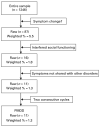The prevalence of premenstrual dysphoric disorder in a randomly selected group of urban and rural women
- PMID: 18366818
- PMCID: PMC2752820
- DOI: 10.1017/S003329170800322X
The prevalence of premenstrual dysphoric disorder in a randomly selected group of urban and rural women
Abstract
Background: Premenstrual dysphoric disorder (PMDD) was included as a provisional diagnostic category in the appendices of Diagnostic and Statistical Manual of Mental Disorders (DSM)-III-R (then called late luteal phase dysphoric disorder) and remained as an appendix in DSM-IV. Our study aimed to determine the prevalence of PMDD using all four DSM-IV research diagnostic criteria in a representative sample of women of reproductive age in the United States.
Method: Data were collected in the homes of women between the ages of 13 and 55 years in two urban and two rural sites using a random sampling procedure developed by the National Opinion Research Center. Women completed daily symptom questionnaires and provided urine specimens each day for two consecutive ovulatory menstrual cycles (ovulation was estimated for women taking oral contraceptives) and were screened for psychiatric disorders by trained interviewers. Symptoms were counted toward a diagnosis of PMDD if they worsened significantly during the late luteal week during two consecutive ovulatory menstrual cycles, occurred on days in which women reported marked interference with functioning, and were not due to another mental disorder.
Results: In the final analysis, 1246 women who had had at least one menstrual cycle and were neither naturally nor surgically menopausal nor pregnant were selected. Of the women in the study, 1.3% met criteria for the diagnosis as defined in DSM-IV.
Conclusions: The prevalence of PMDD is considerably lower than DSM-IV estimates and all but one of the estimates obtained from previous studies when all DSM-IV diagnostic criteria are considered. We suggest a new process for diagnosing PMDD based on our findings.
Conflict of interest statement
Figures
Similar articles
-
Menstrual Cycle and the Prevalence of Premenstrual Syndrome/Premenstrual Dysphoric Disorder in Adolescent Athletes.J Pediatr Adolesc Gynecol. 2015 Dec;28(6):492-8. doi: 10.1016/j.jpag.2015.02.113. Epub 2015 Mar 6. J Pediatr Adolesc Gynecol. 2015. PMID: 26233292
-
Premenstrual disorders among young Turkish women: According to DSM-IV and DSM-V criteria using the premenstrual symptoms screening tool.Perspect Psychiatr Care. 2021 Apr;57(2):481-487. doi: 10.1111/ppc.12656. Epub 2020 Oct 27. Perspect Psychiatr Care. 2021. PMID: 33111372
-
Prevalence and correlates of premenstrual syndrome and premenstrual dysphoric disorder among women aged 18-25 in Turkey.Int J Psychiatry Med. 2024 Jan;59(1):101-111. doi: 10.1177/00912174231189936. Epub 2023 Jul 13. Int J Psychiatry Med. 2024. PMID: 37448169
-
Premenstrual dysphoric disorder: prevalence, diagnostic considerations, and controversies.J Psychosom Obstet Gynaecol. 2006 Dec;27(4):201-10. doi: 10.1080/01674820600747269. J Psychosom Obstet Gynaecol. 2006. PMID: 17225621 Review.
-
[Premenstrual dysphoric disorder (PMDD): Drug and psychotherapeutique management, a literature review].Encephale. 2024 Apr;50(2):211-232. doi: 10.1016/j.encep.2023.08.007. Epub 2023 Oct 9. Encephale. 2024. PMID: 37821319 Review. French.
Cited by
-
Patient Experiences of Health Care Providers in Premenstrual Dysphoric Disorder: Examining the Role of Provider Specialty.J Womens Health (Larchmt). 2022 Jan;31(1):100-109. doi: 10.1089/jwh.2020.8797. Epub 2021 Apr 1. J Womens Health (Larchmt). 2022. PMID: 33978482 Free PMC article.
-
Premenstrual syndrome and comorbid depression among medical students in the internship stage: a descriptive study.Iran J Psychiatry Behav Sci. 2014 Winter;8(4):74-9. Iran J Psychiatry Behav Sci. 2014. PMID: 25798178 Free PMC article.
-
Ovarian Hormones as a Source of Fluctuating Biological Vulnerability in Borderline Personality Disorder.Curr Psychiatry Rep. 2019 Oct 17;21(11):109. doi: 10.1007/s11920-019-1096-y. Curr Psychiatry Rep. 2019. PMID: 31624929 Free PMC article. Review.
-
Premenstrual Disorders: A Primer and Research Agenda for Psychologists.Clin Psychol. 2019 Winter;72(1):5-17. Clin Psychol. 2019. PMID: 32362679 Free PMC article. No abstract available.
-
A scoping review of hormonal clinical trials in menstrual cycle-related brain disorders: Studies in premenstrual mood disorder, menstrual migraine, and catamenial epilepsy.Front Neuroendocrinol. 2023 Oct;71:101098. doi: 10.1016/j.yfrne.2023.101098. Epub 2023 Aug 22. Front Neuroendocrinol. 2023. PMID: 37619655 Free PMC article.
References
-
- APA. Diagnostic and Statistical Manual of Mental Disorders. 3rd. American Psychiatric Association; Washington, DC: 1987. revised.
-
- APA. Diagnostic and Statistical Manual of Mental Disorders. 4th. American Psychiatric Association; Washington, DC: 1997. revised.
-
- Banerjee N, Roy KK, Takkar D. Premenstrual dysphoric disorder – a study from India. International Journal of Fertility and Women's Medicine. 2000;45:342–344. - PubMed
-
- Chambers WJ, Puig-Antich J, Hirsch M, Paez P, Ambrosini PJ, Tabrizi MA, Davies M. The assessment of affective disorders in children and adolescents by semistructured interview. Test–retest reliability of the schedule for affective disorders and schizophrenia for school-age children, present episode version. Archives of General Psychiatry. 1985;42:696–702. - PubMed
-
- Cohen LS, Soares CN, Otto MW, Sweeney BH, Liberman RF, Harlow BL. Prevalence and predictors of premenstrual dysphoric disorder (PMDD) in older premenopausal women. The Harvard Study of Moods and Cycles. Journal of Affective Disorders. 2002;70:125–132. - PubMed
Publication types
MeSH terms
Grants and funding
LinkOut - more resources
Full Text Sources
Other Literature Sources
Medical
Miscellaneous


